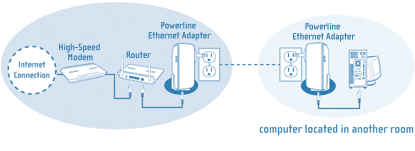Networking with House Wiring
Written by Brian Hogg
Instead of using traditional ethernet cables or wireless to connect multiple computers or other electronic devices, networking with house wiring uses existing copper wire or other wire used to carry electrical power as a communication medium. This provides a quick alternative to running cable through a house or setting up a wireless network, but at the cost of decreased throughput and increased latency or lag between communications.
Contents |
Technology Assessment
Transmission Speeds
Theoretically the maximum speed possible for some devices is 200Mbps[2], however this speed is not realized in practice. Noise from current running in the power lines can limit the possible throughput.
Latency
Because of interference and the various ways in which home wiring is connected, packets may need to be sent several times before they reach a destination intact.[1] This increases the time between a request being sent and a response delivered, or the latency, in communication. Switching to different power recepticals may decrease latency depending on the wiring scheme used.[1]
Security
Because of the way homes may be wired together, communication may be sent to neighbouring houses and intercepted. AES or DES encryption found in the communication protocols of several home wire networking devices decreases the chance of any useful information being intercepted, but physical restrictions on the wiring shared between houses may need to be investigated if security is an issue.[5]
Fault Tolerance
One major concern is the adaptor being plugged into the power outlet and then directly into the NIC. A surge would likely destroy whatever interface card or port the device is hooked up to. However, devices may contain a built-in surge protector and some may run through a typical surge bar.[1]
Power line noise can cause dropped connections, but several devices use frequency hopping techniques to reduce this.[3]
Installation
Installation is relatively straightforward, typically as easy as plugging in the adaptor into the power outlet and plugging the computer into the adaptor. An example of where an adaptor is used in a network can be found in the image below.[3]

Existing Products
General reviews of several existing products can be found below. A larger list of products can be found from homeplug.org.
Linksys Powerline AV Adaptor (PLE200)
The Linksys PLE200 has received very good reviews from ZDNet. Its throughput as tested peaked at 48.5 Mbps, which is on par with wireless networks but slower than traditional wired networks. The device is expensive at $100 for the adaptor or $200 for the kit.[2]
Belkin Powerline Ethernet Adapter
This device is not on the official certified list at homeplug, a body attempting to standardize devices that network using existing house wiring, but offers similar features. 56-bit DES data encryption reduces the probability of communication interception, and a lifetime warranty along with 24 hour technical support make this a worthwhile choice.[3]
Zyxel PLA-400
The successor to the PLA-100 based on the HomePlug 1 specification, the PLA-400 is based on the HomePlug AV specification (backwards compatible with HomePlug 1).[4] Specifically addressed are several quality of service issues. Throughput with testing is still reaching a maximum of 100Mbps, and the average price of approximately $95 for an adaptor remains competitive with the LinkSys and other offerings.[4]
See also
WiFi Security
Public Key Cryptography
Mesh Networks
References
External Links
- HomePlug.org
- How Power-line Networking Works (Howstuffworks)
- Why - Setup a power-line network (CNET.com)